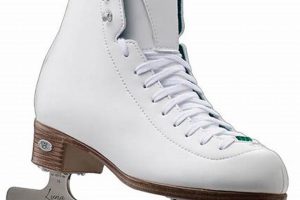Equipment designed for gliding across ice surfaces, specifically tailored for female users and corresponding to a foot length typically associated with size 7 in standard shoe sizing, allows for participation in recreational or competitive ice-based activities. These articles of footwear, featuring a specialized blade attached to the sole, enable movement on frozen water surfaces.
The proper fit and design of these skates are paramount for performance and safety. A size 7 ensures a snug and supportive fit, minimizing the risk of injury and maximizing control during skating. Historically, the development of ice skates has evolved from simple bone blades to sophisticated designs utilizing advanced materials for enhanced agility and comfort, contributing significantly to the sports of figure skating, ice hockey, and recreational skating.
The following sections will delve into the various types of these specialized skates available, key features to consider when selecting appropriate equipment, maintenance best practices to prolong the lifespan of the skates, and safety considerations for optimal use.
Selecting Ice Skates for Women, Size 7
Proper selection ensures comfort, performance, and safety. Consider the following recommendations when acquiring appropriately sized skates.
Tip 1: Accurate Foot Measurement: Employ a Brannock device or similar tool to obtain precise foot length and width measurements. These measurements should be compared with the manufacturer’s sizing chart for accurate conversion to skate size, as skate sizing often differs from standard shoe sizing.
Tip 2: Skate Type Considerations: Identify the primary skating discipline (figure skating, hockey, recreational). Figure skates feature a toe pick for jump assistance; hockey skates prioritize maneuverability; recreational skates offer a balance of comfort and performance for general use. Choose a skate specifically designed for the intended application.
Tip 3: Proper Boot Fit: Ensure a snug fit around the heel and ankle to prevent slippage and maintain control. Toes should lightly brush the end of the boot when standing. Excessive tightness can restrict circulation; excessive looseness compromises stability.
Tip 4: Blade Material and Quality: Blades constructed from high-carbon steel or stainless steel offer enhanced edge retention and resistance to corrosion. Sharpening frequency varies based on blade quality and usage intensity. Inspect blades for nicks or damage prior to each use.
Tip 5: Lacing Technique: Lace skates firmly, concentrating pressure around the ankle to provide support. Avoid over-tightening, which can restrict circulation. Experiment with different lacing patterns to optimize fit and comfort.
Tip 6: Professional Fitting Assistance: Consult with a knowledgeable skate fitter at a reputable sporting goods store. A professional can assess foot characteristics, recommend appropriate skate models, and ensure proper fit through heat molding or custom adjustments.
Tip 7: Initial Break-In Period: New skates often require a break-in period to conform to the shape of the foot. Wear skates for short durations initially, gradually increasing the time spent on the ice to minimize discomfort and prevent blisters.
Adhering to these tips will facilitate the selection of appropriately sized and suitable skates, contributing to a safer and more enjoyable skating experience.
The subsequent sections will elaborate on maintenance practices and advanced performance considerations.
1. Proper Fit
The correlation between “Proper Fit” and ice skates designated as “womens size 7” directly impacts performance, comfort, and safety. Size 7, in this context, represents a specific foot dimension, dictating the internal volume and shape of the skate boot. An ill-fitting skate, regardless of construction quality, compromises the skater’s ability to execute maneuvers effectively and increases the likelihood of injury. For example, if the size 7 skate is too large, the foot will move excessively within the boot, leading to blisters, reduced control, and potential ankle sprains. Conversely, a skate that is too small will compress the foot, causing discomfort, restricted circulation, and potentially long-term foot problems. Thus, achieving a proper fit is paramount to realizing the full potential of the equipment and ensuring a positive skating experience.
The importance of proper fit extends beyond mere comfort. In competitive disciplines such as figure skating and ice hockey, precise movements and rapid changes in direction are essential. A secure and responsive fit within the size 7 skate enables the skater to translate intended actions into accurate on-ice performance. The rigid structure of the boot, when properly fitted, acts as an extension of the skater’s foot and ankle, providing the necessary support and leverage for executing complex techniques. Consider a figure skater attempting a jump; a loose-fitting skate can lead to instability during takeoff and landing, potentially resulting in a fall and injury. In hockey, a secure fit allows for quick acceleration and precise skating maneuvers during gameplay.
Therefore, the understanding and prioritization of proper fit when selecting ice skates labeled as “womens size 7” is not merely a matter of preference, but a critical determinant of both performance and safety. Challenges in achieving optimal fit often arise due to variations in foot shape and inconsistencies in sizing standards across different manufacturers. Consulting with a professional skate fitter is recommended to assess individual foot characteristics and ensure accurate skate selection, thereby maximizing the benefits and minimizing the risks associated with ice skating. This element directly relates to the broader theme of equipment optimization for sports performance and injury prevention.
2. Blade Sharpness
Blade sharpness is a critical factor influencing the performance and safety of ice skates, particularly when considering equipment designated as “ice skates womens size 7.” The sharpness of the blade directly affects the skater’s ability to maintain control, execute maneuvers, and achieve desired levels of performance on the ice. The following points detail the relationship between blade sharpness and these skates.
- Edge Control and Grip
Sharp blades provide enhanced edge control and grip on the ice surface. The sharp edges of the blade allow the skater to “bite” into the ice, providing a stable platform for executing turns, stops, and other technical elements. This is particularly important in figure skating where precise edge work is essential for performing jumps and spins. In ice hockey, sharp blades enable quick acceleration, agile maneuvering, and effective stopping, contributing to improved gameplay.
- Glide Efficiency
While counterintuitive, a properly sharpened blade actually enhances glide efficiency. Microscopic imperfections created during the sharpening process allow a thin layer of water to form between the blade and the ice, reducing friction. This layer of water acts as a lubricant, enabling the skater to glide smoothly across the surface. Conversely, dull blades create more friction, requiring greater effort to maintain speed and momentum.
- Safety and Stability
Sharp blades contribute to overall safety and stability on the ice. Dull blades can cause the skater to slip or lose control, increasing the risk of falls and injuries. Sharp edges provide a more secure grip, reducing the likelihood of unintended slips and providing a more stable platform for executing challenging maneuvers. Maintaining a sharp edge is particularly important for beginners who may lack the experience and technique to compensate for dull blades.
- Sharpening Frequency and Maintenance
The frequency with which blades require sharpening depends on several factors, including the quality of the blade steel, the frequency of use, and the hardness of the ice. Regular inspection of the blade edges is recommended to identify any nicks, burrs, or dull spots. Professional skate sharpening is recommended to ensure proper edge alignment and prevent damage to the blade. Improper sharpening techniques can damage the blade and compromise its performance.
In summary, blade sharpness is inextricably linked to the performance characteristics and safety of “ice skates womens size 7.” Maintaining sharp blades is essential for maximizing control, enhancing glide efficiency, and minimizing the risk of injury. Regular inspection and professional sharpening are recommended to ensure optimal blade performance and prolong the lifespan of the skates.
3. Ankle Support
Ankle support, within the context of ice skates designated “womens size 7,” directly influences stability, control, and injury prevention. This feature, primarily dictated by the boot’s design and material composition, maintains the skater’s ankle in a neutral or slightly forward-flexed position. Inadequate ankle support, regardless of correct sizing, causes ankle instability, hindering a skater’s ability to execute precise movements and increasing the risk of sprains or fractures. Conversely, excessive rigidity can restrict range of motion, impeding performance and causing discomfort. The specific construction and stiffness of the boot are crucial for effectively translating a skater’s intentions into accurate on-ice actions.
The effectiveness of ankle support is particularly evident in different skating disciplines. In figure skating, high levels of ankle support are imperative for performing jumps and landings, where significant force is exerted on the ankle joint. The rigid boot construction provides the necessary stability to prevent ankle roll and maintain balance during these demanding maneuvers. In ice hockey, while a degree of ankle mobility is beneficial for agility and quick transitions, adequate support is essential to withstand the impacts and stresses associated with gameplay. A properly designed boot distributes impact forces, reducing the risk of ankle injuries. Recreational skates typically offer a balance between support and flexibility, catering to a wider range of skating abilities and preferences.
Therefore, optimal ankle support is a critical consideration when selecting ice skates marked as “womens size 7.” Achieving the correct balance between support and flexibility depends on the skater’s skill level, skating style, and the intended use of the skates. Consultation with a qualified skate fitter is advisable to assess individual needs and ensure the selection of a skate that provides appropriate ankle support, maximizing performance and minimizing the risk of injury. While advancements in materials and boot construction have improved ankle support characteristics, challenges remain in accommodating the diverse anatomical variations and preferences of skaters. The ongoing refinement of skate design, focusing on customizable and adaptive support systems, reflects a continuous effort to address these challenges and enhance the overall skating experience.
4. Skate Type
The selection of an appropriate “Skate Type” within the realm of “ice skates womens size 7” directly influences performance, comfort, and safety. The intended use case dictates the specific skate type required. For instance, figure skates, characterized by a toe pick and reinforced ankle support, are designed for executing jumps, spins, and intricate footwork. Hockey skates, distinguished by a more streamlined design and enhanced protection, cater to the demands of speed, agility, and physical contact. Recreational skates, often featuring softer padding and a more forgiving design, prioritize comfort and ease of use for casual skating. Selecting the incorrect skate type can impede performance, increase the risk of injury, and diminish the overall skating experience. A hockey skate used for figure skating, for example, will lack the necessary toe pick for jump execution, while a figure skate used in a hockey game provides inadequate protection against impacts. The correct skate type optimizes the synergy between the skater’s skill set and the demands of the activity.
Practical application of this understanding is evident in specialized retail environments and training programs. Reputable sporting goods stores employ knowledgeable staff who can assess a skater’s skill level, intended use, and foot characteristics to recommend the appropriate skate type. Figure skating coaches often advise students to invest in high-quality figure skates designed to withstand the rigors of intensive training. Hockey coaches emphasize the importance of selecting skates that provide adequate protection and support for the demands of competitive gameplay. Recreational skating instructors guide beginners toward comfortable and forgiving skates that facilitate learning and enjoyment. Furthermore, the proper selection of skate type extends beyond performance considerations to include safety measures. A well-fitted and appropriately designed skate reduces the risk of ankle injuries, foot fatigue, and other common skating-related ailments.
In summary, the connection between “Skate Type” and “ice skates womens size 7” is paramount for achieving optimal performance, comfort, and safety. The intended use of the skates dictates the specific type required, ranging from figure skates for intricate maneuvers to hockey skates for speed and protection. While advancements in skate technology continue to improve performance and comfort, challenges remain in accommodating the diverse needs and preferences of skaters. Therefore, informed decision-making, guided by expert advice and a thorough understanding of skate characteristics, is essential for maximizing the benefits and minimizing the risks associated with ice skating.
5. Boot Material
The performance characteristics of “ice skates womens size 7” are significantly influenced by the boot material. Boot material selection directly affects factors such as ankle support, thermal insulation, durability, and weight, all of which impact the skater’s control, comfort, and safety. Stiffer materials, such as reinforced leather or synthetic composites, provide greater ankle support, crucial for executing complex maneuvers in figure skating and withstanding the forces experienced in ice hockey. Softer materials, such as padded nylon, prioritize comfort and are commonly found in recreational skates. The choice of boot material determines the skate’s responsiveness, its ability to transfer the skater’s movements to the ice, and its overall longevity. An improperly selected boot material can lead to compromised performance, increased risk of injury, and premature wear of the skate.
Examples of boot materials commonly employed in “ice skates womens size 7” include leather, synthetic leather, and various types of molded plastics and composites. Leather offers a classic feel, molds to the foot over time, and provides a balance of support and flexibility. However, leather requires more maintenance and can be susceptible to moisture damage. Synthetic leather offers improved water resistance and durability compared to natural leather, often at a lower cost. Molded plastics and composites, such as carbon fiber or fiberglass, provide maximum stiffness and support, often found in high-performance figure and hockey skates. These materials are lightweight, durable, and offer precise control but may require a longer break-in period. Each material presents a trade-off between performance, comfort, durability, and cost, requiring careful consideration based on the skater’s skill level, intended use, and budget.
In conclusion, boot material is a critical component of “ice skates womens size 7,” directly influencing performance, comfort, and safety. The selection of an appropriate boot material depends on the skater’s skill level, skating style, and the intended use of the skates. While advancements in materials technology continue to improve skate performance and durability, challenges remain in balancing the various performance characteristics and accommodating individual skater preferences. Understanding the properties and trade-offs associated with different boot materials is essential for making informed purchasing decisions and maximizing the benefits of the skating experience.
6. Lace Tension
Lace tension, when considering “ice skates womens size 7,” directly influences foot and ankle support, thereby impacting performance and preventing injury. Inadequate lace tension fails to secure the foot properly within the boot, leading to slippage and reduced control. Excessive lace tension, conversely, restricts circulation and causes discomfort, potentially leading to numbness or even tissue damage. Therefore, achieving proper lace tension, specific to a size 7 foot, is critical. For example, a figure skater requires firm lace tension around the ankle to provide the necessary support for jumps and spins, while a recreational skater may prioritize comfort and opt for a more relaxed tension throughout the boot. Understanding the nuanced relationship between lace tension and foot size is essential for maximizing the functionality of these skates.
The practical application of adjusted lace tension is seen in professional skate fitting and coaching. Experienced fitters assess the skater’s foot shape and skating style to determine the optimal lacing pattern and tension distribution. Coaches instruct skaters to adjust their laces based on the specific activity. Before attempting complex jumps, a figure skater might tighten the laces around the ankle for enhanced support. Conversely, during warm-up exercises, the laces may be loosened to allow for greater flexibility. These adjustments demonstrate that lace tension is not static but should be tailored to the immediate demands of the skating session. Moreover, consistent monitoring of lace tension throughout the session is necessary, as laces can loosen during use.
Proper lace tension is a vital component of the overall performance and safety of “ice skates womens size 7.” Challenges in achieving optimal lace tension arise from variations in foot shape, lace material, and the skater’s own subjective perception of comfort. While technological advancements have led to the development of alternative closure systems, traditional laces remain prevalent due to their adjustability and affordability. A thorough understanding of the principles of lace tension and its impact on foot and ankle support is paramount for skaters of all levels. Ignoring this element can lead to compromised performance and an increased risk of injury. Therefore, proper lace tension should be regarded as a foundational aspect of responsible skating practices.
Frequently Asked Questions
This section addresses common inquiries regarding ice skates tailored for women, specifically in size 7. The following questions and answers aim to clarify essential aspects for informed decision-making.
Question 1: How does “womens size 7” correlate with standard shoe sizing?
Ice skate sizing frequently deviates from standard shoe sizing. A size 7 skate may not directly correspond to a size 7 shoe. Consulting the manufacturer’s sizing chart, based on foot length measurements, is imperative for accurate conversion.
Question 2: What factors determine the appropriate skate type (figure, hockey, recreational) for a size 7 foot?
The intended use dictates the optimal skate type. Figure skates feature a toe pick for jump assistance; hockey skates prioritize maneuverability and protection; recreational skates balance comfort and performance for general use. Skill level and skating discipline are key determinants.
Question 3: What level of ankle support is recommended for a size 7 skate user?
Ankle support requirements vary based on skill level and skating discipline. Beginners and figure skaters generally benefit from higher ankle support. Hockey players may prefer a degree of flexibility for enhanced agility. Proper assessment is crucial.
Question 4: How often should the blades of ice skates, size 7, be sharpened?
Sharpening frequency depends on usage intensity, ice conditions, and blade quality. Regular inspection for nicks or dull spots is recommended. Professional sharpening is advisable to ensure proper edge alignment and prevent damage.
Question 5: What are the key considerations for ensuring a proper fit in ice skates, size 7?
A snug fit around the heel and ankle is essential. Toes should lightly brush the end of the boot when standing. Excessive tightness or looseness compromises stability and control. Professional fitting assistance is recommended.
Question 6: How does the boot material influence the performance of ice skates, size 7?
Boot material affects ankle support, thermal insulation, durability, and weight. Stiffer materials enhance support, while softer materials prioritize comfort. The optimal choice depends on skating style and intended use.
These FAQs provide a foundational understanding of considerations when acquiring or maintaining ice skates in size 7. Careful attention to sizing, skate type, ankle support, blade maintenance, fit, and boot material contribute significantly to a safe and enjoyable skating experience.
The following sections will explore advanced techniques and performance considerations for ice skating.
Conclusion
The preceding analysis has explored key facets of ice skates designed for women, specifically those designated as size 7. The discussion encompassed the critical importance of proper fit, the influence of skate type and boot material on performance, the necessity of maintaining blade sharpness, and the role of appropriate lace tension in ensuring stability and control. These factors, when collectively optimized, contribute to a safer and more effective skating experience.
Continued advancements in skate design and material science promise further enhancements in performance and comfort. However, a foundational understanding of the principles outlined herein remains essential for both recreational and competitive skaters. Prioritizing informed decision-making, coupled with regular maintenance and professional guidance, will ensure the longevity and effectiveness of ice skates, facilitating optimal participation in ice-based activities.


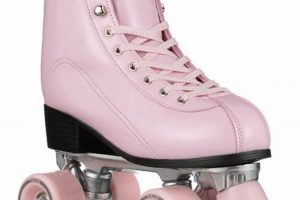
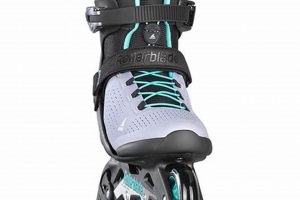
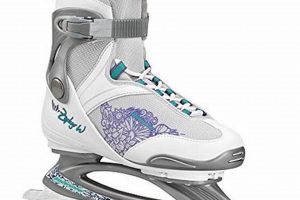
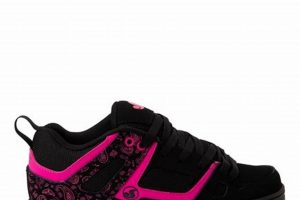
![Top-Rated Best Women's Roller Skates of [Year] - Guide! How to Skateboard: A Beginner's Guide to Your First Board & Tricks Top-Rated Best Women's Roller Skates of [Year] - Guide! | How to Skateboard: A Beginner's Guide to Your First Board & Tricks](https://cruzskateshop.com/wp-content/uploads/2025/09/th-810-300x200.jpg)
